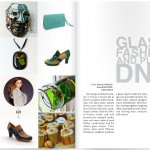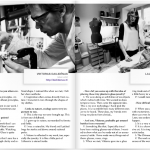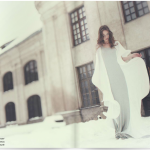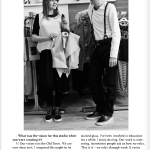llamas’ valley (2012 (8))
Daili design and fashion studio in Vilnius is home both to fashion and glass: leather handbags with glass insets, striped dresses, gray skirts, cream-colored blouses and vests, dropshaped jewelry with the DNA of flowers, herbs, and wild strawberries trapped inside, cups and vases made of used bottles, carafe lamps, and the oddest glass shapes. Their author, glass artist Viktoras Dailidenas, suddenly produces a glass ring he made ten years ago out of a bottle neck for his future wife, costume designer Laura Dailideniene. Here they live, creating together, laughing often, learning from each other, and sharing their creations with others.
VIKTORAS DAILIDENAS www.dailidenas.lt Glass artist
– What is most important to you when creating?
Viktoras: Naturally, we have principles. An artist would not be an artist without principles, a point of view, a mission.
Laura: We are very consistent in our work. I in my field, Viktoras in his. Sometimes our work links together.
– What are these common points?
V: We have found harmony.
L: I see things in Viktoras’ work that I can use in mine. The idea can be Viktor’s sometimes, but I draw my own models. Watching him work is my everyday life. Glass is quite subtle.
V: As a glass artist I can see that Laura has a different view of glass through clarity and refined shape. I noticed this when we met, I felt her clean aesthetic.
L: Inspiration often comes directly from nature. I transmit it even through the shapes of my clothes.
– Links to nature, ecology seem very important to you.
V: This is the way we were brought up. This is from our childhood.
L: I grew up in nature, surrounded by forests and fields.
V: I was a naturalist. My friend and I picked frogs for storks and drove around national parks.
L: Nature is reflected in my work, too, especially the jewelry. It is like a little part of Lithuania is stored inside.
LAURA DAILIDENIENE www.daili.lt Designer
– How did you come up with the idea of placing these tiny plants in glass jewelry?
L: We were doing an exhibition of ice objects which melted with time. We wanted to show temporariness. Then came the opposite idea. This is my own technology, I hand pick the plants. It is incredible how many different ones are to be found. These days, my friends even bring me plants from abroad…
– And you, Viktoras, probably get unused bottles from everyone?
V: Something like that. Especially since I have been making glasses out of them. I wanted to show what can be made out of an unneccessary bottle. I have made many things out of them: glasses, vases, rings.
L: When we met, Viktoras gave me a glass ring made out of a bottle neck. Of course, it is a little heavy to wear…
V: I could modify it!
– How difficult is glass art?
V: When you are young and still learning, with excitement and desire to try everything, there can even be glass shards stuck in eyes… Later, you understand what to do for this not to happen.
L: It is a very expensive art.
V: It is a charming, but monstrously expensive art. It is simply too expensive to be a glass artist today.
L: The Chinese have brought down the prices.
V: The work requires a lot of energy, in all senses of the word. Both human resources and
heat. This is not your normal heating: for glass to be hot, you need at least 1500 degrees.
– What kind of people are glass artists?
V: They’re open-hearted people. Friendly, always helpful, ready to meet. They are daring, and they are few. Real glassmen are few and far apart, we all know each other.
– Designers, on the other hand, are anything but few. How do you manage to remain original, Laura?
L: It takes time. There are many young and talented designers, but it’s not that easy to hang on with the competition what it is today. Our jewelry helps us stay afloat. They are sold in Sweden, France, Spain, we had a presentation in New York several years ago. Of course, then came the recession…
– Where are your sketches born?
L: I am constantly thinking about it. An idea is not born easy, and when it does come, you must draw it, record it, otherwise it will float away.
V: Laura always carries a notebook.
L: Which, of course, fills up very quickly…
– Is there any unique place, especially good for drawing?
V: Laura is very universal. She can create even while driving.
L: Yes, sometimes you see something and it sparks an idea.
– What is it you have to see? Where does inspiration come from?
L: It can be a color, a photograph.
V: I was born and raised among creative people; my parents are painters, Laura is very creative as well. Her ideas have an interesting way of occurring. They are born of simple things which she can view from a different angle.
– Would you wear everything you make?
L: Perhaps not everything. My style changes, but usually I prefer clothes that are more sportswear, free-flowing, knits.
– Who are your clients?
L: Liberated, artistic ladies, although some businesswomen as well.
– Who do you prefer creating for?
L: People who come to you in particular. I don’t work much to order, I have example models which I can resize.
– How did you two meet?
V: It will sound trite…
L: Yes, it was a very banal date.
– February 14th?
V: Yes. You see… We were both studying in Kaunas. It must have been sophomore year, we were in some performance. I was Lady Valentine, and she was a salmon. That was when I first saw Laura, and then I got her phone number through friends
– Are you similar?
V: We do have things in common.
L: It would probably be difficult without them for two creative people with children waiting at home to boot.
V: I’ve always said that in order to keep a family, live and enjoy life, one must first have forgiveness, be capable of predicting the situation and seeing that the other person needs to be helped. Sometimes you must budge first, then there will be no friction. We don’t have any friction, because we don’t let it happen.
– But you still probably talk about the same things at home?
L: We can’t… There are two children at home. Though they are pretty independent by now: one is eight, the other three.
– Artists as well?
L: One is a naturalist, a mathematician. He is wonderful at counting! We came home yesterday to a house full of origami butterflies. He says, mommy, I’m going to sell them…
– What matters most to you in a home?
V: That it is safe and well-lit.
L: Maybe not so much safe as cozy.
V: Well, yes. This year I remembered my old passion, bought an aquarium, and started breeding African cichlids. They are pretty, colorful fish. Cichlids are somewhat cleverer than other fish. They build gardens out of pebbles and then guard them. They react to the environment and to humans.
– What was the vision for this studio when you were creating it?
V: Our vision was the Old Town. We are now close to it. I imagined this ought to be both a shop and a workshop. It is now. We even have glass art classes here sometimes. Usually for foreigners, I teach them how to make stained glass. I’ve been involved in education for a while. I enjoy sharing. Our work is interesting. Sometimes people ask us how we relax. This is it we relax through work. It varies from stained glass to blown lamps, from handbags to dresses. So many different things can’t be boring.
Photos: Robertas RIABOVAS, Reda MICKEVICIUTE, A.SIDLAUSKAS
llamas’ valley – http://www.lamuslenis.lt













